I went through the brake light, battery break-in method for my Z20A and put together the results of the first 5, 2-amp, discharge/bank charge cycles. I will probably do a few more, since it is too darn cold to ride anyway :(
It seems that I got all of the charger/bike wiring done correctly on the first try, but the PakTrakr logs are telling me something is goofy with one of the chargers. Unless, it is the battery? I will get a new charger, test it and post the results.
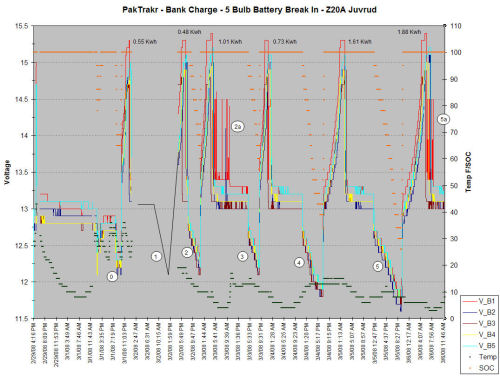
Attached is a Word doc that I put together that includes details on my setup/process, a full size version of the graph, and additional pictures. Sorry for making it an attachment, but it was easier to format than a regular post.
Questions:
1) Immediately after charge, can you begin discharging? Is it necessary to let the batteries sit for a while after charging? Should you wait between charge/discharge only during break-in?
2) How is the PakTrakr State of Charge (SOC) calculated and what does it mean?
Example: At end of Discharge 5, PakTrakr displayed SOC was 26% and each battery was 11.5 volts. I’m assuming this means that I have 26% to go before hitting a danger point, and not that the batteries are 26% away from full discharge.
I know there are more folks that would appreciate any info from others on their setup, process and results.
| Attachment | Size |
|---|---|
| 491 KB |



I'll forgive you if you tell me how you did attach it! ;-)
Mr. Mik
This information may be used entirely at your own risk.
There is always a way if there is no other way!
When you create a new forum topic there is an expandable item for attachments (1MB limit). It is directly above the Preview/Submit buttons.
I guess the attachment option isn't available for comments. Bummer.
Now that it is posted though, I have no idea how to post any future updated versions.
Here is a close up of the charge cycle in the center of the original (above) with the erratic red line (Battery 1). Maybe someone has seen this before and can give me a diagnosis.
I looked through the PT logs, and Batt1 will jump from ~13.4V to ~14.5V every 2-10 minutes. The logs were set to record every 15 seconds. It is typically a single log entry that shows the spike and then it is back to normal. There are occasional instances of 2 or 3 consecutive spiked entries.
I can provide full logs if that will help.
Instead of getting a new charger, why don't you swap chargers and see if the problem follows the battery or follows the charger? My guess is that it will follow the charger. It seems like something is set incorrectly inside the charger, and instead of floating when it's done, it detects (incorrectly) that the battery is too low and begins another charge cycle. If this is correct, you will need a replacement charger anyway, but at least you could know right away.
ZEV 7100 Alpine
Fort Collins, CO
I swapped charger 1 & 5 and didn't really get a definitive result.
Previous Discharge/Charge Cycle:
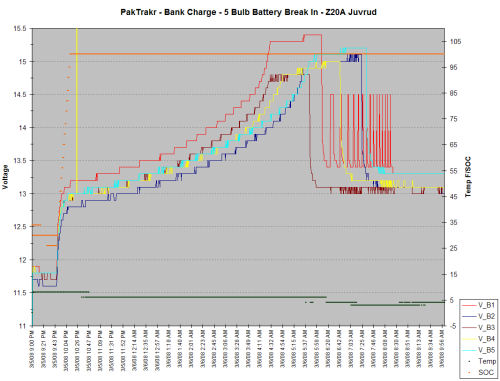
Battery 1 on Charger 1; Battery 5 on Charger 5
On float, Battery 1 would periodically jump from 13.4 to 14.5. All other batteries appeared fine.
There was a single record (30 sec interval) on Batt4 that indicated 23V (yellow spike). Probably just weirdness.
Most Recent Discharge/Charge Cycle: (Swapped Chargers)
Battery 1 on Charger 5; Battery 5 on Charger 1
If Charger 1 was bad, I would have expected Batt5 to start jumping - but it was only on float for <30 minutes. I should have left it longer to see what happened but had to disconnect else leave it on all day. If Batt1 was causing it, I would expect those frequent jumps again. Frequent jumps were not seen on either, but Battery 1 & Battery 3 did have a sustained jump to 14.4V and 14V respectively.
If I would have left them on float longer I would have gotten better data. I guess it will need further testing.
Perhaps it's just the cold weather. It was -2F during most the charge.
mikejuv,
That's interesting. Maybe the chargers are reacting somehow to the temperature?
I bought 8 vector VEC1087CBD 10/6/2 amp 12v chargers and will do a full review. In a nutshell one was going too high in voltage, and another was not bringing the voltage high enough.
So, I think its entirely possible to get 2 out of 5 bad chargers. In your case, It looks like the charger for both batteries 1 and 5 were bringing the voltage up higher than the rest. I'd switch 1 with a different charger, and see what happens.
[url=/forum-topic/motorcycles-and-large-scooters/587-my-kz750-electric-motorcycle-project]KZ750 Motorcycle Conversion[/url]
[url=/forum-topic/motorcycles-and-large-scooters/588-fixing-my-chinese-scooter]900 watt scooter[/url]
Pic from http://www.electri
I agree. Both 1 & 5 were a bit above the rest, and I should have swapped it for another to test.
It's interesting that each batt (or charger) tops off to a slightly different voltage, but it has been the same peak voltage for each batt on every cycle after the first discharge. I'm curious if it is because of variations in each charger or battery (possibly both). I will do a few more cycles of a couple hours each, rotating chargers to different batts, leaving each on float for an hour or so. I'll swap the chargers on the high batts with the low ones and see what happens.
2 of 5 chargers being bad is a high rate of failure for a product (oh - wait, I have a Z so I shouldn't talk about high rates of failure ;)). However, I suppose the typical customer wouldn't notice the problem, and the variation is allowed to slip by as acceptable. After all, there are only a few of us nerds that would actually do performance analysis on something like a battery charger 8)
What is the recommended upper voltage limit during charge. I've read on V before that too high a voltage will start to 'cook' or sulfate the batteries? Is hitting 15V too high?
In my opinion hitting 15v is too high. I would like to see the voltage go no higher than 14.8 at room temperature to be comfortable. Most AGM spec sheets I've reviewed recommend 14.4-15v, so optimal might be right around 14.7v, and this appears to be close to the average of the B&D vector chargers that I bought. I'll give more detail when I post the review. The higher quality more expensive batteries like Hawkers or Concord could probably tolerate abuse better, but I would be more careful with the cheaper chinese batteries.
From the EV download library: EVTAMERICA - Sealed Lead Acid Batteries Designed for the Z-20 and R-20 (6FM33D) Spec Sheet.
FYI, too high a voltage will cause out gassing. Hydrogen and oxygen will be vented from the battery using up the available water in the electrolyte. AGMs don't have much available electrolyte, but they can usually recombine hydrogen and oxygen well. Unfortunately, recombining hydrogen and oxygen results in heat, and this could lead to thermal runaway if charging a warm battery especially with a defective charger.
[url=/forum-topic/motorcycles-and-large-scooters/587-my-kz750-electric-motorcycle-project]KZ750 Motorcycle Conversion[/url]
[url=/forum-topic/motorcycles-and-large-scooters/588-fixing-my-chinese-scooter]900 watt scooter[/url]
Pic from http://www.electri
Would it be possible to use a high-powered charger to alternate between batteries automatically?
This would get rid of the problem of a faulty charger in the bank charging setup (just think of the 8 chargers needed for a 96V system - the more chargers, the lower the likelihood that they will all be similar).
Some battery types seem to be limited by the temperature rise caused by high charge currents.
Giving them a very high current for a short time, then letting them cool whilst the other x batteries in the bike are being charged might enable fast, on-board charging.
One very high quality charger that switches between batteries.
Or even better: A high quality CONTROLLABLE charger that takes instructions from (open source) software running in a Pocket-PC like device, integrating data from cycle-analyst, pac-tracker or whatever else and timing the charging according to immediate as well as longer term need.
Settings would be adjustable from: "Get me 20km range ASAP so I can get out of this weather" to "Spoil the batteries for the next 72hrs whilst I am away. You know their history....Full rejuvenation Tx."
Mr. Mik
This information may be used entirely at your own risk.
There is always a way if there is no other way!
It would be, but it would require a lot of switching. And, it would have to really hit the batteries in say a 5 battery system with 5x the current. Or, it could switch fast enough to where you'd have about 1x the current with capacitors to smooth out the spikes, in which case it'd be a 5 output charger.
That's a neat idea. I wonder if a simple circuit with some semiconductors and capacitors could be homebuilt, than we can purchase a large 40-50 amp 12v charger? hmm...I'll have to look into that.
Some people have setup lower voltage systems to switch all the batteries in parallel so they can charge with just one 12v charger. Unfortunately batteries can't be wired in series and parallel at the same time, so this requires a lot of switching.
Mik:
This would get rid of the problem of a faulty charger in the bank charging setup (just think of the 8 chargers needed for a 96V system
That's a serious problem I'm trying to figure out. I'm going to have 16 batteires on a Civic conversion, so 16 chargers is ridiculously complex from an engineering perspective.
[url=/forum-topic/motorcycles-and-large-scooters/587-my-kz750-electric-motorcycle-project]KZ750 Motorcycle Conversion[/url]
[url=/forum-topic/motorcycles-and-large-scooters/588-fixing-my-chinese-scooter]900 watt scooter[/url]
Pic from http://www.electri
I ran another test, swapping around the chargers to different batteries. This time I was able to get a clear result. The charger demonstrated the same behavior on this new batt. The charger does appear to be bad.
In this test the suspect Charger (1) was moved to Batt 3. On float for 2 hours - sustained jumps from 13.1V to 14.2V. The peak charge was also less in this charge cycle - nothing over 15.1V.
Most recent test (cycle 7) - Suspected Bad Charger on Batt 3 (Brown line)
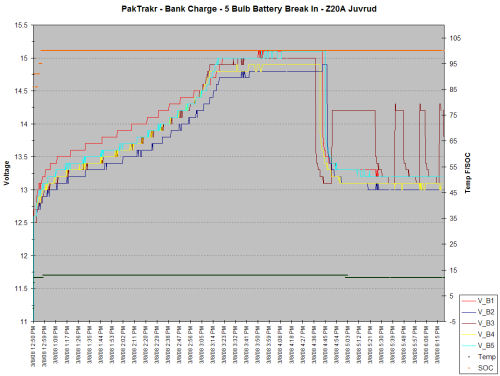
In the first 5 cycles, the suspect charger was on Batt 1 (red in original post), and during previous float periods it showed the same behavior although for only brief durations.
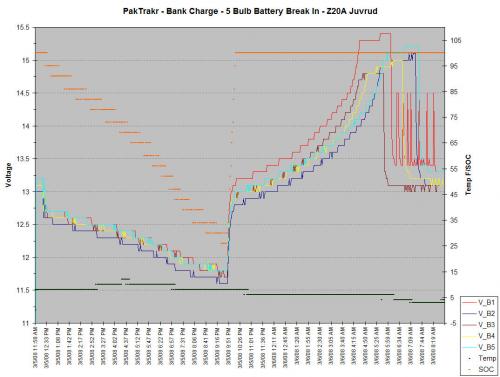
Cycle 5 - Bad charger on Batt 1 (red line) [same data as shown in original post image - different time scale]
In the previous inconclusive test, this charger was on Batt 5 (light blue in earlier post), but no jumps were seen since it wasn't floating for very long before I had to disconnect chargers. In that cycle there were jumps on other batteries, but it was -2F and those batts hadn't shown those jumps before - so I'll leave that in the odd column until I see it again.
I don't know if this float behavior is necessarily bad for the battery, but since it appears to be abnormal I will assume it isn't good and pick up a new charger. We'll see if that stops it.
After I replace the charger, I'll do another test and post the results.
Earlier, I was writing in Randy's thread about the challenges of keeping an Emax, but since my four EB 20-12 batteries arrived, I will post here, especially since I am trying to condition my batteries like mikejuv who started the thread. If nothing else, it is a useful educational process for me.
I'm very glad I bought a paktrakr, and I'm pleased that I'm a bit closer to getting back on the road.
I've completed one original top-up charge and one discharge & charge per usatracy's plan (the one that mikjuv refers to above). I'm using Vector 2 amp chargers (VEC 080).
Only one charger kicked in for the top-up and one seems to have turned on and off, creating spikes in the graph below. Maybe this is all par for the course, as the batteries all started out at 13.1 or 13.0 volts?
Initial top-up
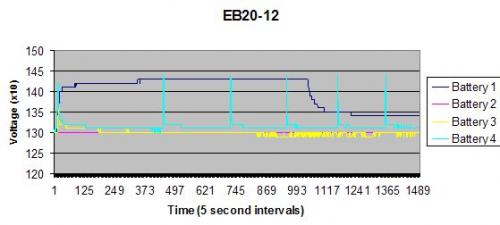
The process of a discharge to 12.5 volts (using 2.1 amp bulbs) took just over 8 hours and then re-charge took 3 hrs 44 minutes.
First discharge to 12.5 volts and then charge
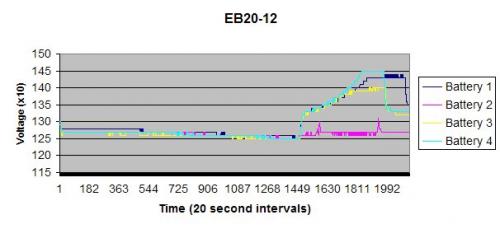
Charger #2 on battery #2 showed a green light not long after charging began, but did not charge battery #2, so I will be returning that charger to Lowes tomorrow. Chargers 1-3 seem to have performed basically as expected, though I note that they cut off at different voltages (especially charger 3 which cut off at 14 volts). Even with the strange behavior of charger #2, they all displayed green lights in the end.
Since battery 2 didn't charge, I took it out of the string and charged it alone with charger #1. I'll let them all settle over night, get the replacement charger and try a discharge to about 12 volts next.
Having charged up Battery 2 on its own, I have reconnected the batteries, I am ready for another low amp discharge (down to 12 V this time). Its been about 11 hours since I finished charging battery 2 and its been a couple of hours since I put battery two back into the string.
The individual battery voltages are:
Battery 1: 13.3
Battery 2: 13.2
Battery 3: 13.1
Battery 4: 13.2
Are these resting close enough to one another? Does it cause a problem when the batteries aren't all at the same voltage when any discharge begins? Hard to imagine how this would happen to work out in daily use, never mind in a testing context, but I thought I would ask.
Today I topped off my batts as the bike had sat for a week. One of my chargers did the same. However, after going for an 8-mile ride and doing a full bank charge it didn't repeat. I haven't downloaded my PakTrakr data yet - so no fun graphs today :(
I'm mulling over a couple ideas:
- Somehow related to "topping off" an already full battery (charger algorithm/logic)
- Charger going bad (revenge for not being used for a week)
- Bad connection of charger wires at terminal strip (only thing that was modified since last charge)
- Random weirdness
Until it happens again, I will assume it is just a fluke. If it does happen again, I will swap chargers to different batteries and see if it repeats.
Across my 5 batts I typically see a range of 0.2V.
When riding - I believe your weakest battery is the max so a single low battery will effect performance. If you string charge the pack with a low battery, the charger won't know that one batt is low and will end up overcharging the others. But I don't think a 0.1V variance is enough to worry about. From the stuff I've read on the forum, it seems like you won't cause a problem until a battery really starts getting out of sync. What that variance cut off is, no one has stated. Hopefully there are enough folks logging their PT data to be able to figure that out.
PakTrakr Full-Ride-Bank Charge Profile
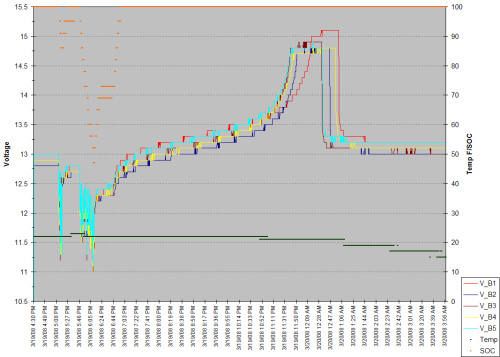
Here are a couple things to note about PakTrakr data:
Has anyone verified the accuracy of the PakTrakr?
Here is the response I received from the PakTrakr folks when asking about PT data precision (3/10/08)
PakTrakr questions I still have:
Why does the PT indicate such a huge drop in voltage when the batteries are being used, compared to the voltage reported after having let the bike rest for 5+ minutes. In the above image, the two big dips are when the scooter is being ridden. The plateau between the dips is a period of 20 minutes where the bike was stationary. During use, the PT seems to show inaccurate data and the scooter's built in State of Charge gauge seems more accurate. I know I need a Cycle Analyst for an accurate "fuel gauge", but am still curious.
Uhhh... that's normal battery behavior.
SLA batteries and most other chemistries dip in voltage when you put a load on them, and as soon as the load is lessened or reduced the voltage comes back up. There's a trick you can use when the pack is deeply discharged, to stop for a few minutes and let the batteries rest. This is known as 'growing volts'.
- David Herron, The Long Tail Pipe, davidherron.com, 7gen.com, What is Reiki
mikejuv, thanks for the feedback. I'm about to begin my second discharge and recharge, with a replacement charger.
I've appreciated having your graphs for comparison.
I'm finding some differences between my multimeter and the PakTrakr as well, though to my eye they look slight. If the multimeter is accurate, it turns out my batteries are in better balance than I thought. It does seem a bit weird that the battery which the PakTrakr says has the highest charge actually has the lowest among the four.
I disconnected the PakTrakr momentarily to recalibrate it and it shows the same voltage that it was previously reporting.
When I start riding next week, we'll see if I get the same uneven drops in voltage on the PakTrakr that you are observing. (I presume you were saying that the initial dropped seemed larger than the second? Maybe you were riding harder before the batteries were rested?)
By the way, how are you generating the time and date stamps in your graph from the hour/min/sec data that comes out of the PakTrakr?
If you haven't yet snipped most of the charger wire to the terminal strip to keep things tidy, I would recommend you only snip off the terminal clamps, leaving most of the wire intact. It will leave a lot of extra charger wire. But if the charger needs to be returned, you can simply solder the clamps back on and return it without a problem.
After using Hyperterminal to capture text, the "Date Modified" attribute of the resulting text file is a good approximation of the time of the most current PT record in the file. Since PT record time is the offset from reset, using this as the time reference and determining each records offset from the most current, you can calculate an adjusted/"real" time.
In my case, I've created an Access database that imports/processes PT data and outputs customized reporting data to Excel for graph generation.
PakTrakr Data Processing/Reporting Access DB Interface

I still have to work on direct communication w/ PT to eliminate need for Hyperterminal text capture. If you are interested in using it - PM me.
I completed my second discharge (this time down to 12.1-12.2 v) and the replacement charger (#2) seems to have performed well, though it plateaued for quite a while at 14.6 v before shutting off. This time, charger #3 reached its peak of 14.0-14.1 volts in second place to charger #4 but then stayed at that level until I pulled the plug. It was at that plateau for 2 hours and 21 minutes.
Can anybody provide any guidelines on the point at which one's batteries start cooking? I'm committed to using a timer to shut things down, especially once I get a grip on how long charging really takes. I think I'm o.k. here, I just want to make sure that I don't let things go too long or that the chargers are taking the charges too high before cutting off.
I completed my fifth and final discharge and charge, but I probably goofed it up a bit. By the time I got to the fourth cycle, it was taking over 41 hours to discharge and then charge. I had been using experience from previous cycles to estimate the length of the upcoming cycle to try to avoid being asleep when a charge needed to start or end. It seemed to be working fine until this last cycle.
When I woke up this morning, the brakelight bulbs were all out and the paktrakr was no longer working. I immediately disconnected the bulbs and began a charge. When the paktrakr immediately came back on it registered the batteries at 11.4-11.6 volts and a multimeter reading showed that the paktrakr (PT) was registering the charges accurately.
Pretty soon after the charge begin I started getting overcharge error messages from the PT, though I assumed that was because it was not able to calibrate itself from a 100% charge when it turned back on. I just kept monitoring the rising charges with the PT and a multimeter.
Here is where my question comes in. As the chargers reached or came close to their maximum charges of about 14-14.5 volts, I was waiting and watching for them to begin to shut off per usual. However, I suddenly heard a high pitched and very staccato squeak from one of the batteries. Could this be outgassing?
As you can see from the graph, I turned the power to the chargers off all at once, and now, a little over an hour later, the batteries have all returned to 12.8-13.0 V. 12.8 and 12.9 are a little low since the batteries have been settling to 13.1-13.3 previously I also note that there was some unusual erratic charging with battery/charger #2 right toward the end.
At any rate, any thoughts from anyone on the squeak?
I'll do another gentle discharge and recharge just to see how they respond, and then I plan to put them in the Emax this weekend.
e-commuter, that sounds like venting. It is highly dependent whether this is cause for concern. Sometimes it can indicate a bad/weak cell, or cells. It can also just happen rarely, which is normal. It can also indicate too high a charging voltage obviously.
The batteries were probably over-discharged. If you've got a power supply that can do CV, I'd put all the batteries in parallel on 14.7v for a day or two. This should help to recondition them.
They can also be charged at a slightly higher voltage of 15v or over, but be careful. This may cause gassing and internal pressure buildup which can cause the cells to bulge. It may also cause thermal runaway, so monitor them if you chose to do this.
At the extreme, I was recently trying to recondition a motorcycle battery by charging it at 200 amps! I did this by using a load tester to vary the current from two 12v good batteries in series (24v) wired to the motorcycle battery. It was spraying acid after a few seconds, so please don't try anything like this. I've reconditioned smaller batteries by charging them at 16v+ for a few hours and externally cooling them. But they gas so much that they need water added.
A 12v to 120v inverter would be a much safer way to condition cycle the batteries if it has a LV cutoff. B&B just recommends charging the batteries at a constant voltage of 2.45vpc for 10-24 hours depending on how long it's been since being manufactured to condition them.
[url=/forum-topic/motorcycles-and-large-scooters/587-my-kz750-electric-motorcycle-project]KZ750 Motorcycle Conversion[/url]
[url=/forum-topic/motorcycles-and-large-scooters/588-fixing-my-chinese-scooter]900 watt scooter[/url]
Pic from http://www.electri
Thanks Andrew. Sounds like I'll need to go buy a constant voltage charger, at least long enough to condition these batteries. I hope I can find one at Home Depot. If anyone has suggestions of favorite chargers, I'm all ears.
So, do I understand correctly that personally you would safely charge all four batteries at once in parallel at 14.7v for 1-2 days. OR charge each battery individually for 10 hours (they're brand new batteries) at 2.45 volts per cell per B&B recommendations.
The inverter with low voltage cutoff is a good idea. I was only planning to discharge them that much once, so hopefully I won't need to do it again until I buy new batteries, and I hope that is a long time from now.
Out of curiosity, does the conditioning damage the long-term life of the battery even if it restores them to daily operating condition?
Thanks again.
A constant voltage charger actually won't do it, because these are designed just to deliver a full charge then shut off or go into float mode, which is optimal for regular charging. A CV power supply however could be left on longer. I don't know of a good place to find one cheaply. Maybe ebay? I imagine that a PC power supply could be modified. Also, radio shack carries some voltage regulators which can be used for this purpose with a transformer power supply or other battery(s) as input.
To be safe, I might do it a little lower like maybe 14.5v so they don't have as much risk of heating up. Whether the batteries are in parallel or charged individual should not matter to them if the charger can supply enough current to maintain 14.5v/battery, but this shouldn't be much if they are fully charged.
The conditioning, meaning holding at 2.45vpc for 10-24 hours, should not damage them, as long as they are not left on ridiculously long (like more than a few days). However, this will certainly damage them if they are always left on at this voltage after fully charging them. For normal charging, a charger needs to either shut off, or go into float voltage (a lower CV) mode after fully charging the battery.
[url=/forum-topic/motorcycles-and-large-scooters/587-my-kz750-electric-motorcycle-project]KZ750 Motorcycle Conversion[/url]
[url=/forum-topic/motorcycles-and-large-scooters/588-fixing-my-chinese-scooter]900 watt scooter[/url]
Pic from http://www.electri
Andrew,
I think I may be ok. I contacted a B&B technician who asked me how long the chargers were on before they cut off. He pointed out that they probably cut off before the batteries had fully charged. Without getting into all of the details, I tried a top-up charge and then a shallow discharge and re-charge and despite some trouble with erratic fluctuations in the chargers and one charger that decided not to charge, I now have four batteries that seem to be settled at 13.0-13.1 volts. Hopefully whatever sulfation occurred was slight.
I'm going to have to keep my eye on these Vector chargers. I appreciate that they were inexpensive, but I'm not sure what to make about the occasional erratic behavior. Maybe it was a product of such a deep discharge.
e-commuter
e-commuter,
Don't mean to jump in on this long discussion, but I've never heard anywhere, not would I know of any reason, that new SLA's benefit in any way from these "break-in" cycles. What exactly is your objective of doing this?
PJD:
Well, at a minimum, it just gave a newbie like me an opportunity to get a feel for battery performance and with the PakTrakr attached to figure out how my chargers are working etc. (more on that shortly).
To answer your question, USA Tracy had a blog up (which I believe has been removed now) detailing a break-in process that supposedly improves the surface area of the plates.
The link to info at amplepower.com is http://amplepower.com/primer/break-in/index.html
I have installed the batteries and went for my first gentle ride.
I think I need some charger advice if anybody is willing.
I was pleased to find that I got nearly 2 miles of gentle riding out of my four batteries, and hopefully I'll be able to get sufficient normal riding after a couple more gentle rides.
However, I'm getting erratic behavior out of these 2 amp Vector chargers (VEC080). Charger #3 (connected to Battery #3) has never charged as high as the others, and I don't know if this is a problem. Plus, as you can see on the graph below, chargers 1 and 4 went into spasms after having gone through what appears to be a normal charging process. This caused the PakTrakr to throw off alerts saying that batteries 1 and 4 were failing.
1st ride on EB 20-12 batteries 4-6-08
This isn't normal is it?
The documentation that came with the chargers says "2/1 Amp Automatic Float Mode Battery Maintainer" I can't find specs anywhere on the internet to figure out how they expect it to operate. I presume a correct charge should go up to about 14.4-14.5 volts for a while before falling off to a float mode of about 13.2 or 13.3 volts. Maybe that float mode is happening in there amidst all the fluctuation, but I can't tell.
(Battery 2 doesn't seem to be floating, and even if batteries 1 & 4 are floating at 13.3 and 13.1 volts (respectively) from which they fluctuate, there is still a lot of fluctuating going on.)
I bought mine at Lowe's but they seem to be the same as the Black & Decker ones.
e-commuter, I don't know what's with those chargers. My B&D 10/6/2 chargers all go to about 14.5-14.8v, and hold the voltage constant until the current tapers to about a half an amp or so then cutoff current.
And if left on, they might go into float mode after a while, and hold that for a few minutes. They don't appear to pulse on and off rapidly, but if left on for a few hours I can see how they might go into float mode multiple times to top off the batteries, where the normal mode cutoff current is probably slightly high meaning they may need this to deliver a full charge.
I'm having trouble understanding your graph. How often do they pulse on and off, or what's the interval for doing that?
Anyway, I feel that the charging system with n number of chargers for batteries is a complex system. You might consider a series/parallel re-wiring setup.
[url=/forum-topic/motorcycles-and-large-scooters/587-my-kz750-electric-motorcycle-project]KZ750 Motorcycle Conversion[/url]
[url=/forum-topic/motorcycles-and-large-scooters/588-fixing-my-chinese-scooter]900 watt scooter[/url]
Pic from http://www.electri
The float voltage is 13.6 to 13.7 for my chargers. That seems off what yours are.
[url=/forum-topic/motorcycles-and-large-scooters/587-my-kz750-electric-motorcycle-project]KZ750 Motorcycle Conversion[/url]
[url=/forum-topic/motorcycles-and-large-scooters/588-fixing-my-chinese-scooter]900 watt scooter[/url]
Pic from http://www.electri
I can't answer that question with perfect precision. I had the Pak Trakr set to sample the voltages every 15 seconds, so there may have been some spikes that fell between the samples, but for charger 1 in the first column of the selection I have pasted below, it appears to be approximately every 45 seconds to 1 minute (or a little less depending on whether you believe the 13.4 voltages marked below were capturing the voltage just as the charger had begun to apply charge). Charger 4 in the fourth column was also spiking but less frequently.
I'm of course open to suggestions. I have been trying to follow the growing consensus about bank charging, so I have the four batteries wired in series, with one charger connected to each battery. Is that what you understood I was doing?
Pages